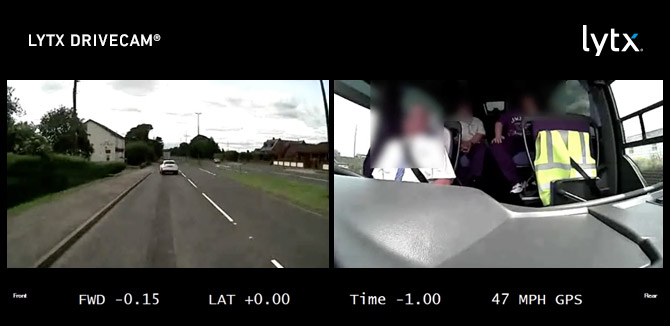What is a Vision Zero initiative? If you haven’t already heard about Vision Zero, it’s a movement that’s sweeping through cities and countries all over the world, including Canada, Sweden, and more than a dozen U.S. cities and states. The goal is to achieve zero fatalities or serious injuries from road traffic.
Among the major cities to announce a Vision Zero initiative is London. By 2030, the city’s mayor, Sadiq Khan, wants zero fatalities in London from city buses. By 2041, the mayor wants all deaths and serious injuries from road collisions to be eliminated from London’s streets, which are among the most congested in the world.
It’s a tall order for a metropolis of 8.8 million people, 2.6 million registered passenger vehicles, and 9,590 city buses. In 2016, 116 people were killed from road traffic collisions in London. Although down from 136 a year earlier, it’s still a distance from Mayor Khan’s goal, outlined in his Vision Zero initiative.
The city’s public transportation agency, Transport for London, in November outlined a plan for accomplishing this zero-collision goal. The plan includes a host of technologies and design fixes, including automatic emergency braking, intelligent speed assistance, audible alerts, standardized brake pedals, and video cameras to help eliminate driver blind spots, among other things.
How can the Vision Zero initiative be met?
Del Lisk, Lytx’s vice president of safety services, recommends adding one additional element to the list — driver coaching techniques.
“Why? Because the driver is still ultimately in charge of the vehicle,” Lisk said. “You can have a host of technologies to assist you, but if the driver isn’t on board, it would be difficult to make progress.”
To illustrate, watch the video above with your audio on. As the bus approaches the slowing passenger vehicle, the bus’s advanced driver assist system is beeping to warn the driver to slow down. The system beeps for several seconds before the emergency brakes kick in, throwing passengers into the windshield.
“The issue is that most people believe they are better than average drivers, but that everyone else on the road is average or below average,” Lisk said. “Complacency settles in, and they’re often not aware that some of their driving habits may be exposing them to more risk. The mindset is that I’ve done this countless times without incident, so it’s perfectly safe.”
This is particularly true for bus drivers, who often have static and repetitive routes, for instance. In a 2017 Lytx analysis of 103 million transit miles, static trips were more likely than average to experience a collision or near collision, while trips with a variable route were less likely to experience a collision or near collision.
The road to zero collisions
Many of the leading indicators for collisions are related to human behavior. For example, in a risk ratio analysis of preventable collisions presented at the Lytx User Group Conference in February, nearly half can be attributed to five driver behaviors:
- Lack of awareness at intersections (attributed to 14.1 percent of preventable collisions)
- Distraction (10.8 percent)
- Late response (10.6 percent)
- Neglecting to use mirrors (8.0 percent)
- Unsafe lane change (5.9 percent)
Breaking poor driving habits requires human intervention. But that doesn’t necessarily have to be a negative intervention, said David P. Scott, who worked at UPS for 33 years and is now a senior safety specialist at WGL, a utility company based in Washington, D.C. In fact, Scott, who presented on a panel at the Lytx 2018 User Group Conference on effective coaching strategies, said the key to seeing his organization’s safety metrics moving in the right direction was a driver recognition program that relies on video-based driver coaching, positive reinforcement, and celebrating successes. If the driver was captured on video using defensive driving skills to avoid a collision, they’d receive a gift card.
“And, if they allow us, we use the video (outside view only) for training across the company,” Scott said. “Another tool that has been readily accepted is intervening with drivers on the top 20 riskiest driver report. We sit down with them in a positive manner. I review their riskiest behaviors and we discuss how to correct them. When they get off the top 20 list they get rewarded with a gift card. That is very positive.”
Scott’s video-based coaching program became so widely accepted that the company’s union leaders insisted that the program be implemented across the entire fleet so all drivers can be assessed fairly.
“They wanted all-in,” Scott said. “That in and of itself is very rare, because you would think they wanted it out.”
Vision Zero goals are attainable
An effective driving coach, combined with video telematics technology, can help significantly reduce collision risks. The U.S. Department of State saw zero fatalities and zero preventable collisions within the first 18 months of its coaching program, with more than 1 million miles driven around its embassies worldwide.
Kristin K. Gwin and Greg Wolfe, safety experts at the State Department’s Office of Safety, Health and Environmental Management in the Bureau of Overseas Buildings Operations, concluded in an article in State Magazine, “The hundreds of hours of information collected from [the] DriveCam [program] have proven there are things drivers can do to reduce crash risk in dangerous overseas traffic conditions.”
To learn more about how the vision zero initiative goals can be met, we encourage you to see how Lytx products can be used to help improve driver performance. Also, you can visit our resource hub for articles, ebooks, and best practices.
